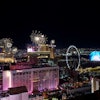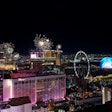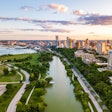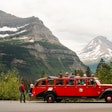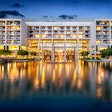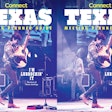When Jon Trask first got wind of last October’s Las Vegas shootings, he was stunned. “There’s obviously the shock and craziness of it,” says Trask, CMP, CMM, president of Strategic Meeting Tech in Orange, California.
Like millions of other Americans, he followed the endless news updates on the gunman, holed up on the 32nd floor of Mandalay Bay Resort and Casino, and his 59 victims attending a country music festival below. “I have friends in Vegas, one of whom could hear the sirens and shots from his house,” says Trask, a 30-year meetings industry veteran and longtime live music fan. (He’s seen Bruce Springsteen some 40 times.)
When the shock began to subside, Trask started thinking more about the bigger picture and how such a horrific situation could have happened. Remembering the Station nightclub fire in Rhode Island that killed 100 people in 2003, Trask had a sense of deja vu. “It was the same feeling,” he says. “What could have been done differently? What were these people thinking—or were they thinking at all?”
It Does Happen Here
No doubt many people were pondering those questions—and others—in the wake of the Vegas shootings.
Only a year earlier, in Manchester, England, and Paris, similar tragedies played out at large group events, resulting in extensive injuries and loss of life. In those instances, security experts have examined what happened before, during and immediately after the violence occurred, and considered what might have been prevented or done better.
They appreciate the daunting challenges of deterring and intercepting an act of violence, as well as mitigating the damage once it’s occurred. But those experts also agree that what happened in Vegas won’t be limited to Vegas. Many groups fall far short of having a serious plan in place to deal with such incidents, they say, or, worse yet, refuse to consider that it could happen to them.
“The active-shooter world is one of the most difficult to deal with,” says Harold Hansen, CFE, principal and managing partner of Venue Management Consultants Group in Chicago.
Hansen, who also sits on the board of the Event Safety Alliance, says after Paris and Manchester it was only a matter of time before a similar incident happened stateside. He’s concerned the Vegas shooting has not been a sufficient enough reality check for some planners.
“‘It’s not going to happen here. Why would a terrorist want to hurt someone in Fargo, Fort Wayne or Kalamazoo?’ is a fundamental belief of many people in the industry,” says Hansen. He emphasizes that people don’t recognize that while the probability of a bombing or shooting is small, it’s still possible.
For those who won’t acknowledge that possibility, being unprepared if something does happen can be overwhelming. “The problem then becomes that you are not ready to hear the gunshot because you haven’t thought about it,” he says.
Most active-shooter situations last five to seven minutes, he says, with the police typically arriving once the shooting’s stopped. “That makes the event manager the immediate responder,” says Hansen. “You need to know what you should do, and that means you have to have thought about it beforehand.”
Plan For Security
That lack of forethought has troubled others in the meeting world, including MPI President and CEO Paul Van Deventer, who has expressed concern over reports that many planners don’t have a solid emergency preparedness plan ready to go. “It’s crazy; we work in a soft-target environment,” he says. “That’s the reality.”
Van Deventer felt strongly enough about it to form an ongoing alliance with the University of Mississippi’s National Center for Spectator Sports Safety and Security last year. Its first effort, a certificate-level emergency preparedness course for MPI members, debuted at the World Education Congress last summer in Las Vegas—just weeks before the shootings.
For former FBI agent Gary Gardner, the Las Vegas attack represented a “paradigm shift” in terrorist tactics in the United States.
“Active shooters generally have been at ground level, not shooting from an elevated platform down into a crowd of people,” he says. Gardner, CEO of TotalAccess in Charlotte, North Carolina, and a security consultant for NCS4, says that style of attack has not been seen here since 1966, when Charles Whitman shot and killed several students from the University of Texas at Austin’s clock tower. It serves as a reminder to the meetings and hospitality industry that any tall buildings, including hotels, are fair game for gunmen.
Gardner urges all planners to form a risk assessment group well in advance of an event (see next page) and engage local law enforcement officials, as well as other authorities, in the process. “I don’t think it’s in the nature of what planners have been used to doing,” he says.
He also warns that while hoteliers, venue managers, transit firms and other hospitality vendors should participate in a group’s risk assessment team, planners should not rely solely on those vendors to supply their event safety. “Assuming somebody else is doing something for your own security is a bad safety net,” says Gardner.
Know Your Vulnerabilities
Threats to an event can come in a variety of forms, big and small, local and global. Planners should consider all potential dangers for their risk assessment plan. Dr. Lou Marciani, director of NCS4, stresses the importance of awareness and thinking outside the box.
For starters, “We need to do a better job reaching out to the ‘perimeters’ of these events,” he says, referencing hoteliers, conference venues and tangential vendors such as restaurants, parking garages, nightclubs, museums and sports clubs.
Be frank when asking about their own security game plans: Have they practiced active-shooter exercises with the local community authorities? How safety-trained are service employees such as maids, waiters, ushers, parking attendants and groundskeepers?
Is “see something, say something” a given with everyone on the event’s perimeter? “Years ago people didn’t have to worry about that, but they do now,” says Marciani.
Meagan Catafi, training and program manager for the California Police Chiefs Association, makes a point of getting to know her meeting surroundings for herself and through the eyes of her attendees.
“I’m in a different city each year for both of my major events,” says Catafi. “I take the extra steps to see things from our attendees’ perspective and ask the local police department what areas are safe and what I should be careful of.”
Catafi’s surroundings also include the attendees themselves. “If everyone on the show floor is wearing a suit and you see someone dressed in jeans and a T-shirt, then that should set off an alarm,” she says. “It’s about recognizing who might not belong.”
Events may also be at risk due to their very raison d’etre. Film and music festivals and major athletic events (e.g., the Super Bowl, World Series and college tournaments) attract high-profile celebrities and average attendees, as do political and social-cause conventions. They also draw protesters, often partisan, both pro and con the event, which necessitates much tighter security and awareness levels. That said, even a milquetoast meeting of milk producers can generate protests with the presence of a single controversial speaker.
Controversy also loves company.
While your own event may be as secured as humanly possible, the same might not be true for the animal rights meeting at the adjacent hotel or the gun enthusiasts sharing your convention center. If you’ve discovered these potential flashpoints early in the planning stages, then other booking choices are options. If not, get neighborly.
“Go to the hotel next door, tell them you’re having an outdoor event and that you want to coordinate security, and most will be cooperative,” says Gardner. “If they blow you off, then at least you’ve put them on notice.” At that point, contact the local police who, concerned with possible crowd control issues, may agree to post someone at your event as a precaution.
Working Within A Budget
If you’re organizing the Oscars or planning a Super Bowl halftime show, then money is no object when it comes to security. For the rest of the planning world, though, there are ways to make a meeting, reception or playoff game safer, and do so without spending a fortune.
Working with local law enforcement officials can be beneficial beyond simply paying them to supply extra bodies for your event.
“They have public information officers, people who have the pulse of what’s going on in a city,” says Catafi.
That knowledge can help planners avoid protest marches, traffic jams and other disruptions. While they can’t always provide security, she adds, police may have a patrol person available to direct human and automobile traffic.
Catafi is also strict about credentialing her group before and during events, and having attendees and staff wear their badges, whether it’s on the show floor, at a seminar or in the hospitality suites. “If you don’t have a name badge then you don’t come in,” she says.
Shooters, bombers and other terrorists rely on crowd panic and confusion to cause further injuries and fatalities during their attacks. Most venues provide basic lighting and sound, but planners can certainly bolster AV elements to suit their own specific safety requirements.
“Having good graphics up and running can give people a sense of direction during a crisis,” says Trask. Digital signage and lighting can highlight orderly pathways to easy exits, while using prerecorded emergency announcements can provide instant audio guidance and free up event staffers to assist people in others ways.
